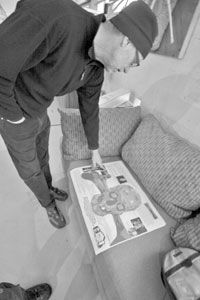|
| ||
| Rebel with a cause
by Stew Mosberg
And while the roles may seem polar opposites, Madeen brings the same unique perspective to home design as he does to protest art. “Intrinsic to my design philosophy is the concept of dichotomy – the celebration of dualistic concepts,” he says. Madeen’s latest show, “I would not believe that, even if it were true,” a one-man, mixed-media, political art exhibit is on view at the upstairs Art Library at the Durango Arts Center. Prepare to be shocked at what the artist refers to as “Wake Up!” art. Some of the images may offend the senses, not in a profane or salacious way, but because they are deeply disturbing in their depiction of violence and human cruelty. The less visceral images and objects however, remain equally as powerful. By its very nature, protest art is controversial, confrontational and challenging and has been around for as long as people have needed self-expression, no matter how radical. Modern-day protest art grew out of the political turmoil of the 1960s. Those demonstrations and art happenings featured placards and banners, live performances and other formats, to deliver messages to the public without the formal confines of galleries and museums. While the DAC library is a quasi-art gallery space, there is no question Madeen’s work is artfully designed and constructed. He is a master of his materials, whether they are post-industrial waste – recycled electronic parts, wires, semi-conductors and mother-boards – or print-outs from global internet sites. His experience with cabinetry gives him a working knowledge of fastening and binding devices, chemical compounds, and a host of materials not often used as art mediums. His work is meticulous in its detail and execution, and while some of the messages he projects might be obscure to all but the most politically savvy, others are in-your-face remonstrations. Many address world or national issues, some even focus on local concerns. The cerebral Madeen doesn’t separate his skill-set into different categories. For him, the processes are similar. “Creative thinkers,” he says, “wander beyond the bounaries of the mainstream and test conventional assumptions. This has always been my motivating touchstone: using materials and creating spaces in truly innovative and unorthodox ways, but keeping them germane to human needs and aspirations.”Even with their inherent messages, Madeen’s dimensional pieces are as intriguing to explore visually as they are to decipher. In the case of political commentary, he holds strong to universal conspiracy theories and devotes much of his art to proving them. His studies at the Art Institute of Chicago incorporated sculpture, painting and photography, all of which he uses in his artwork today. One common approach to his dual professions is discovering new applications for frequently used materials or “taking them out of their usual or intended context and placing them in another,” as he explains. While the tiny DAC library space limits the scale of the work that can be displayed, Madeen has managed to include numerous pieces constructed with materials as diverse as sliced paper and concrete, stuffed animals, turkey feet, steel and even that ubiquitous substance, high fructose corn syrup. One of the largest pieces, “American Dream,” is a fascinating construction made from thousands of shredded advertisements taken from fashion and home design magazines selling products and decor unavailable to all but the elite class. Considering that the venue is a library, he has also included the written word. There are numerous binders on hand containing rhetorical commentary by the artist. This written part of the collection is highly educational, hence the show’s somewhat enigmatic title. Included is correspondence he sent to legislators along with their less-than-satisfactory “form letter” replies. In homage to his political beliefs, Madden has provided a unique method for collectors to avail themselves of the work on view, a sort of silent auction. “I will not be pricing any of the work,” he says. “People can put down what they are willing to pay or trade for.” As controversial as his work may be, the exhibit is a must see and given his lack of local representation, this is a great opportunity to experience it. The artist raised hackles last summer with his forged iconic rocket bearing an upside down, distress signal flag. But isn’t that what protest art is supposed to do? Wake people up, get them thinking and most of all see and hear another point of view? This show is no exception, and the DAC is correct to give the populace a chance to make up its own mind. The show is not about shock value but an attempt to scare people awake. “If you don’t question your belief system,” argues Madeen, “you are under some kind of mind control.” This is an extraordinary show, and it must be carefully viewed as well as read in order to comprehend the magnitude of the work and Madeen’s message. The exhibit runs through Feb. 24. The Durango Arts Center’s current Barbara Conrad Gallery show, “The Four Corner Commission,” and its extension at the “Salon de Rochester,” are on display through January. •
|



 Jeff Madeen operates in two different worlds, or so it would seem. On one hand, he is a talented designer of dream kitchens and cabinetry; on the other, he is a soft-spoken, yet passionate protestor. His dissent, in the form of art, is aimed at large corporations, the utility, gas and oil cartels, banks and insurance companies, and the government.
Jeff Madeen operates in two different worlds, or so it would seem. On one hand, he is a talented designer of dream kitchens and cabinetry; on the other, he is a soft-spoken, yet passionate protestor. His dissent, in the form of art, is aimed at large corporations, the utility, gas and oil cartels, banks and insurance companies, and the government.